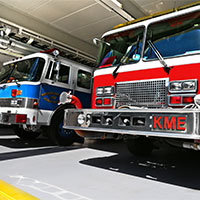 Shores may need to beef up staffing on its fire engines
Shores may need to beef up staffing on its fire engines
STORY
When the Indian River Shores Public Safety Department gets a 911 call about a fire, not only does a fire engine and an ambulance roll out of the station, but cross-trained officers in police cars rush to the scene to pitch in.
While that approach has worked well in the Shores – officers are triple-trained to do police work, fight fires and handle medical emergencies – the agency that determines a town’s fire protection rating for homeowners insurance purposes doesn’t reward this innovative approach.
As a result, the Shores could wind up downgraded by the International Organization for Standardization (known worldwide as ISO) in the coming months, and if the rating is bad enough, homeowners could be in for big increases in their homeowners insurance bills.
A major worsening of the town’s rating, Mayor Brian Barefoot said, “doesn’t cost more for the Town, but costs more for the taxpayers.” To prevent this, the Shores Town Council is bringing in an expert to see what can be done prior to the upcoming inspection by ISO.
ISO ratings run from 1 being the best to 10 being the worst. At its last rating in 2007, the Shores was scored a 4. That was prior to several key retirements in the Shores Public Safety Department and the shift from using all full-time staff to some per diem workers to save money.
“I feel very strongly that we would not be in that category now,” said Acting Public Safety Director Capt. Mike Jacobs. “The way we’re currently staffing our trucks, we could potentially score very badly.”
According to Jacobs, ISO officials want to see a crew of six trained firefighters roll on every fire call. The Town only sends two firefighters in the fire truck and one in the ambulance – a total of three. Cross-trained personnel who arrive on the scene only count as a half a firefighter by ISO standards.
“ISO looks at the way the truck is staffed when it leaves the station,” Jacobs said. “They want six firefighters on two trucks, and I currently have three people in the station.”
Staffing resources are only one factor ISO officials look at, other aspects being dispatch, water distribution systems (hydrants), response time and training of personnel. Training on the fire side of things, Jacobs said, is also not as robust as it could be, as the focus is currently on the law enforcement end of things. “We just do the bare minimum (fire) training.”
Councilman Dick Haverland said he got an education in ISO ratings when he went out looking for property insurance and said, “I was told our town of all the towns qualified in the best,” adding that his insurance agent told him there were two tiers of ratings – the lower numbers considered good and the upper bad and that his carrier charged a 10 percent surcharge on properties in areas rated in the riskier tier.
Haverland in January proposed a staffing study of the Public Safety Department and his idea was voted down by a 3-2 decision with Haverland and Councilman Tom Slater in the minority.
Vero resident and 41-year insurance professional Gene Waddell, principal of Waddell & Williams Insurance Group, ran a test-rating of a home in the Shores for Vero Beach 32963 to see what a downgrade might mean in costs to homeowners.
“We have rated a traditional-sized home in John’s Island and rating it as a protection class 6 and class 8 gives the identical premium. The problem would occur if the town went to a 9 or 10. That is with the most popular market we use so others may be different, but it doesn’t appear that there would be an insurance argument here. It would certainly be a slap in the face to move backwards, especially since the county is rated a 4.”
Another factor besides cost is the choice of carriers that the Shores currently has with an ISO rating of 4. If the Town’s score slides, could that limit Shores’ residents’ options in the insurance marketplace? “That might be a good possibility,” Waddell said. “The protection class determines the fire rate and couple that with the ocean-side wind exposure, the residents would catch both barrels.”
Should ISO officials calculate a score of 9 or 10 for the Shores, the Town would most likely need to beef up fire staffing, based upon what’s happened in other communities, Jacobs said.
“Upper Captiva Island went from a 5 to a 10 and they were already at the maximum millage (property tax) rate,” Jacobs said. “ISO says 10 is unacceptable, that they want some corrective action.”
The Shores’ plan is to bring in an expert for a one-day consultation at a cost of $1,000. That should happen in the next two to three weeks, and then the Town Council will look at his recommendations and decide what to do. Vice Mayor Jerry Weick said the town needs to cover itself in case something goes wrong, and Slater agreed that fire service needs to be by the book.
“This is a town that tries to be the best at everything we do and I don’t want to change that,” Slater said. “When that call is received and that truck rolls, I want to make sure that truck is properly staffed.”








